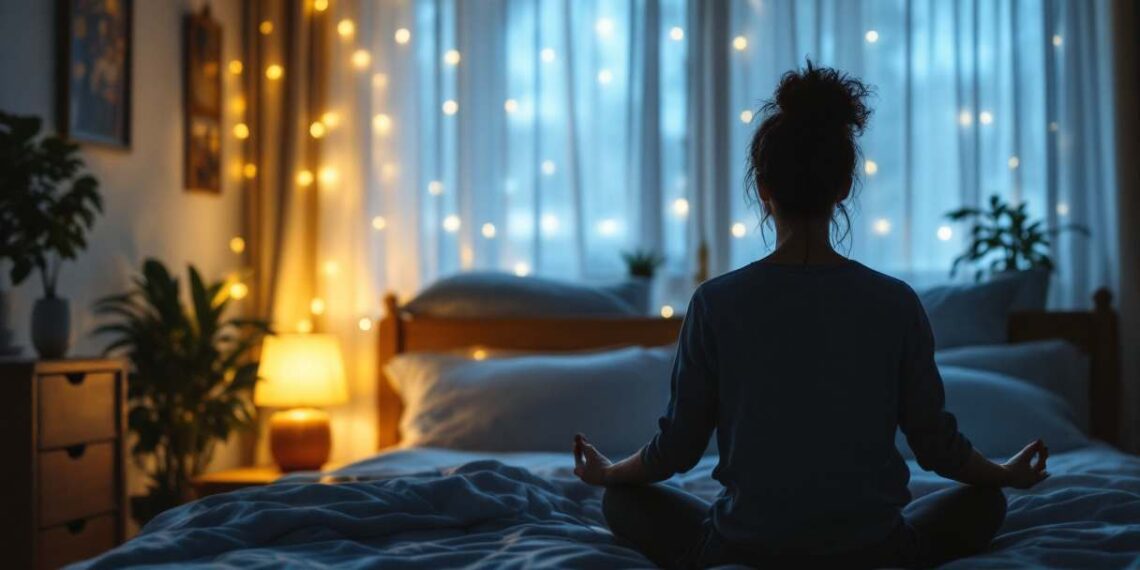Ever find yourself staring at the ceiling, sleep elusive despite your tired eyes? If counting sheep just isn’t cutting it, perhaps it’s time to explore the soothing world of bedtime meditation.
By weaving simple meditation techniques into your nightly routine, you can gently nudge your mind and body toward a more restful state, paving the way to dreamland with ease.
Introduction to Sleep Meditation
Why Good Sleep Matters
Getting good shut-eye is crucial for feeling great and keeping your health in check. It’s the time when your body does its fixing and your brain smooths out the wrinkles in its fabric, making you fresh and cheerful. Without enough sleep, your brain gets foggy, you catch colds more easily, and stress mounts up like dishes after Thanksgiving dinner. Loads of folks have a tough time drifting off due to hectic lives, stress galore, and screwy sleep schedules. For those looking to tuck themselves in naturally, it’s worth checking out what can make bedtime the cozy wind-down it should be.
Did you know grown-ups need about 7-9 hours of blissful sleep every night to keep the gears running smoothly? Here’s a quick-look table with the sleep scoop by age:
| Age Group | Recommended Sleep (Hours) |
|---|---|
| Infants | 12-16 |
| Toddlers | 11-14 |
| Preschoolers | 10-13 |
| School-age | 9-11 |
| Teenagers | 8-10 |
| Adults | 7-9 |
| Older Adults | 7-8 |
How Meditation Can Make Your Night
Slipping some meditation into your bedtime routine can turn nights into dreamland. These chill-out techniques help everything slow down, leaving worries in the dust and setting the stage for peaceful rest. Peek at what meditation can do for your zzz’s:
- Stress and Worry Buster: Meditation turns the volume down on anxious chatter, making it easier to doze off without a care.
- Sleep That Counts: Research gives a nod to meditation, showing it helps dive into that sweet, deep slumber. Say goodbye to tossing and turning.
- Sharpen That Mind: Keeping meditation on the regular helps with focus and brain power, tackling tasks with the precision of a Swiss watch.
- Swap Pills for Peace: For those wanting to step away from sleep meds, meditation offers a side-effect-free path to restful nights.
- Here and Now Living: It’s all about being present. Before you snooze, meditation helps soak in the moment, leading to perfect relaxation.
If you’re up for trying more natural ways to snooze better, why not check out some herbal sleep aids or dabble with essential oils? Pairing these with meditation might just be the ticket to dreamy nights.

Mindfulness Meditation
Mindfulness meditation’s all about being right where you are and noting what’s going on in your head, what you’re feeling, and the physical sensations—without wagging a finger at yourself. This can be a real game-changer for hitting the hay and staying asleep since it kicks stress to the curb and turns the dial on relaxation up a notch. Here’s a rundown on mindfulness meditation and some bedtime tricks to try it out.
“Mindfulness meditation can help ease the racing thoughts that keep you awake. It’s a simple practice that can make a big difference in how well you sleep.” — Sleep Therapist
Definition and Basics of Mindfulness Meditation
Mindfulness meditation’s a fancy way of saying, “Hey, focus on what’s happening now,” while you watch your thoughts and emotions float by like clouds. The whole point is to not get sucked in by them. Doing this before dozing off can help your brain and body switch off for the night.
Here’s what you need to know about the gist of mindfulness meditation:
| Element | Description |
|---|---|
| Awareness | Zoning in on what’s happening right now. |
| Non-judgment | Letting thoughts and feelings show up without a fuss. |
| Breathing | Using your breath to keep your mind from wandering. |
| Acceptance | Not stressing about changing your thoughts. |
Techniques for Practicing Mindfulness Meditation Before Sleep
Check out these handy methods for getting your mindfulness meditation on before catching z’s:
Body Awareness Relaxation:
Kick back and get cozy.
Shut your eyes and think about each body part, starting from the toes and working up.
If something’s tense or bothering you, breathe into it and let it chill out.
Mindful Breathing:
Plop down or lie back in a comfy spot.
Pay attention to your natural breathing rhythm.
Count to ten as you breathe in and out, and if your mind trails off, start from scratch.
Gratitude Reflection:
Before turning in, recall three things you’re thankful for.
Let those warm and fuzzy feelings fill your mind, creating a relaxed vibe.
Guided Mindfulness Meditation:
Grab a meditation app or some audio with guided sleep sessions.
Follow the gentle voices to ease into a peaceful night’s rest.
Visual Imagery:
Imagine a chill place like a quiet beach or woodsy nook.
Dive into the specifics, using your senses to paint a soothing mental picture.
Stirring these mindfulness meditation tricks into your nighttime routine can help you nod off without popping any pills. For more natural sleep hacks, check out our piece on how to sleep better naturally.

Body Scan Meditation
Overview of Body Scan Meditation
Body scan meditation is a chill and surprisingly effective way to plug into your body’s vibes. It’s perfect for those moments when your mind is racing ahead but your body just wants to crash. This practice nudges you to check in with each part of yourself, dialing down the stress and dialing up the calm. It’s especially golden if you find yourself tossing and turning at night wondering if counting sheep might actually work. Forget the sleep aids; by tuning into your body, you release stress and glide into a peaceful slumber. It’s definitely the superhero among sleep meditation tools.
Step-by-Step Guide to Body Scan Meditation for Sleep
Here’s a no-nonsense blueprint to help anyone conquer body scan meditation and catch those elusive Zs:
| Step | Action |
|---|---|
| 1 | Get Comfy: Stretch out on the sofa or bed, wherever’s peaceful. Nestle into a cozy spot, and let your eyelids fall shut. |
| 2 | Breathe It Out: Start with some deep breathin’, letting your belly fill as you inhale through the nose, then see the stress float away with each slow exhale. |
| 3 | Zone In on Your Toes: From your pinky toe on up, notice every twitch and itch. It’s kinda like saying hi to all the parts of your body you’ve ignored. |
| 4 | Let Go of the Grumpy Bits: When you bump into tension on your body tour, visualize the worries melting away with a warm, relaxing ooze. |
| 5 | Cruise Onward: Travel through your lower legs, tummy, up to chest, arms, neck, and wrap up at the noggin. Each sensation’s a signpost. |
| 6 | Bask in Zen: After your body check, just chill. Let the relaxation wash over you like a soft blanket. |
| 7 | Ease Back Into Reality: Wiggle those fingers and toes like waking from a dream. Give it a beat—no rush to bolt up. |
Slotting body scan meditation into your nighttime ritual can really turn sleep into something to look forward to. For more cozy thoughts and tricks to drift off peacefully, peek at our other reads on natural sleep tips and chill breathing routines. Let this meditation be your flashlight in the dark forest of wakefulness, helping you cozy up to a night of blissful sleep.

Guided Visualization Meditation
Understanding Guided Visualization Meditation
In the groove of guided visualization meditation, you dive into mental pictures to chill and find your zen. It’s like a guided daydream, with someone’s voice — live or recorded — painting calming images in your mind. You might wander through a peaceful beach or a quiet forest. These visuals help your noggin escape stress and anxiety.
This meditation style can work wonders if you toss and turn at night or want a natural sleep aid. The colorful mental cinema takes you to chillville, relaxing you enough to switch off a racing brain and sail smoothly into dreamland.
Using Guided Visualization for Relaxation and Sleep
Weaving guided visualization into your nightly wind-down can supercharge your sleep mojo. Here’s how to get started:
- Set Up Your Comfort Zone: Pick a chill spot to park your body — somewhere quiet where interruptions are no-go.
- Pick Your Audio or Script: Grab a guided visualization recording or jot down your own mellow script. Tons of freebies are out there if you look around online.
- Chill Out: Close your peepers, breathe deep, and get your mind ready for a cozy mental trip.
- Sense it All: When you’re visualizing, let all your senses join the party. Picture the sights, listen to the sounds, sniff the smells, and feel the vibes of your imagined retreat.
- Focus on Chillin’ Out: Dive deep into your mental backdrop. If random thoughts crash the party, gently steer your attention back to your happy place.
- Stick to the Routine: Make this a nightly habit. Train your mind to kick back and let it know it’s sleep o’clock.
| What’s What | What to Know |
|---|---|
| Time Frame | 10-20 minutes is usually sweet |
| How Often | Bust it out each night for best vibes |
| Setting | Calm, comfy, and soft on the eyes |
| Source of Tunes | Follow guided audio or pen your own script |
Looking to upgrade your sleep even more? Check out breathing exercises for sleep or dip into yoga poses for sleep. These extras can boost your bedtime routine, offering a fuller ticket to dreamland.
Progressive Muscle Relaxation
Explanation of Progressive Muscle Relaxation
Progressive Muscle Relaxation (PMR) is like a chill-out session for your body. It’s this cool relaxation trick that helps folks shake off stress and bodily tension. The idea is to tense up and then loosen different muscle groups one by one, leading to a nice, calm state physically and mentally. By giving attention to separate body parts, PMR not only cools tension but also increases mindfulness, making you more aware of how stress and relaxation feel.
“Progressive muscle relaxation is a powerful technique to release tension from head to toe, preparing your body for a restful night.” — Wellness Coach
For anyone battling those annoying restless nights or hunting down natural sleep hacks, PMR is gold. It can mellow you out and get your sleep rhythm back to where it should be, helping you snooze more soundly.
| Good Stuff About Progressive Muscle Relaxation |
|---|
| Loosens up muscle knots |
| Eases you into relaxation |
| Boosts sleep coziness |
| Promotes being in the moment |
How to Perform Progressive Muscle Relaxation for Better Sleep
Wanna give PMR a shot? Here’s a simple way to do it right when you’re aiming for some quality shuteye. Pick a quiet, snug spot and follow these steps to get the most from this relaxing body method.
Find a Comfy Spot: Plop down or lie around in a place where you feel cozy. Make sure your environment is chill and distraction-free.
Close Your Eyes: Breathe in deep and shut those peepers. Let your breathing take center stage in your mind.
Tighten Up Each Muscle Group: Start with your feet, tighten the muscles for about five seconds. Notice that sturdy sensation.
Loosen Up the Muscle Group: After the tensing, let go of the tightness, easing your muscles into relaxation. Feel the difference between tight and loose.
And Move Up: Work your way through every part, tensing and chilling out each muscle group. Try this order:
- Feet
- Calves
- Thighs
- Belly
- Back
- Arms
- Shoulders
- Face muscles
Breathe Deeply: Once you’ve relaxed everything, focus on deep breathing. Suck in air through the nose, hold it a sec, then slowly let it out through your lips.
| Muscle Group | Tighten Time | Loosen Time |
|---|---|---|
| Feet | 5 secs | 30 secs |
| Calves | 5 secs | 30 secs |
| Thighs | 5 secs | 30 secs |
| Belly | 5 secs | 30 secs |
| Back | 5 secs | 30 secs |
| Arms | 5 secs | 30 secs |
| Shoulders | 5 secs | 30 secs |
| Face | 5 secs | 30 secs |
Wrap Up with a Peaceful Scene: Imagine a serene picture or place to crank up the relaxation, making snooze time even better.
Doing PMR can be a lifesaver for folks wrestling with sleep woes. For more snoozing hacks that don’t rely on meds, check out our guide on how to sleep better naturally. Slide this into your nighttime groove for a chilled-out vibe and more peaceful z’s.
Breath Awareness Meditation
Breath awareness meditation is like a trusty old friend, there to help you unwind after a hectic day. Pay attention to your breathing, and you might just find the secret to a night of deep, satisfying slumber. By zoning in on each breath, folks can quiet their racing minds and settle down for some well-deserved rest.
Incorporating Breath Awareness into Your Meditation Practice
Getting into the groove of breath awareness meditation is pretty straightforward. Here’s the lowdown on how to get started:
- Get Cozy: Plop down somewhere comfy, a spot where interruptions are as rare as a blue moon.
- Close Your Peepers: Shutting your eyelids helps tune out the chaos of the world.
- Breathe Deep: Take big gulps of air through your nose and let them out slowly through your mouth. Do this a few times to mellow out your thoughts.
- Breathe Naturally: Once you’ve chilled out, zero in on your regular breathing, just watch each breath coming and going naturally.
- Feel the Vibe: Notice how each breath makes your chest rise and fall or how the air feels as it enters and exits your nose.
- Refocus If You Drift: If your thoughts stray like a wandering sheep, gently bring them back to your breathing.
Do this for about 5 to 15 minutes – even if life’s a whirlwind, there’s usually time for a quick breather.
Breathing Techniques for Relaxation and Sleep
There are some cool breathing tricks to help you relax and catch some quality z’s. Here are a few you might want to give a try:
| Breathing Technique | What’s the Deal? |
|---|---|
| 4-7-8 Breathing | Breathe in through the nose for 4 seconds, hold for 7, and smoothly exhale for 8. Repeat a few times. It’s like a lullaby for your nerves. |
| Diaphragmatic Breathing | Put a hand on your chest and the other on your stomach. Take deep breaths into your belly without moving your chest too much. |
| Box Breathing | Breathe in for 4 seconds, hold for 4, out for 4, and hold again for 4. Repeating this can be as calming as a hot cup of tea. |
| Mindful Breathing | Let each breath flow easily. If your mind wanders, gently bring it back to your breathing. |
Mixing these breathing techniques into your bedtime routine can be a game-changer for sleeping like a baby. It’s particularly handy for those who often go one-on-one with insomnia or rely too much on sleep meds. For more handy tips on catching those Z’s naturally, hop over to our page on how to sleep better naturally.
Loving-Kindness Meditation
Concept of Loving-Kindness Meditation
Loving-kindness meditation, also known as Metta meditation, is like a warm hug for your mind and heart. It’s a chill practice that encourages spreading love and kindness to yourself and those around you. It’s super handy for those nights when counting sheep just won’t cut it.

This meditation is all about quietly repeating phrases that send out vibes of love and good intentions to yourself and others. As you do this, those pesky negative thoughts and feelings tend to drift away, making it easier for you to catch some Zs. Creating a good vibe can really get you in the groove of relaxing and unwinding.
Practicing Loving-Kindness Meditation to Promote Peaceful Sleep
Want to add a little loving-kindness meditation to your bedtime ritual? Here’s how you do it:
Get Comfy: Plop down in a quiet spot where you won’t be bugged. Whether you’re sitting or lying down, just make sure you’re feeling relaxed.
Shut Your Peepers: Close those eyes to zone in. Take a few deep breaths to bring yourself to the now.
Start with You: Kick things off by sending some love your way with phrases like:
“May I be happy.”
“May I be healthy.”
“May I be safe.”
“May I live with ease.”
Spread the Love: Once you’ve given yourself some TLC, start sending those vibes out to your nearest and dearest, the lady at the coffee shop, or even the grumpy guy on your bus:
“May my loved ones be happy.”
“May all beings be healthy.”
Keep Going for a Bit: Let this roll for about 10-15 minutes. Let your thoughts wander, but don’t get too hung up on them.
Breathe it Out: Finish by focusing on your breathing. Imagine inhaling more love and good feelings, and breathing out stress and negativity.
Adding this into your nightly routine can be a game-changer for anyone dealing with the occasional sleepless night or wanting to ease off the sleeping pills. It gives your mood a little lift, easing you into a restful mindset. For more chill tips, check out our guides on yoga poses for sleep and essential oils for sleep.
Benefits of Loving-Kindness Meditation for Sleep
Here’s a quick look at how loving-kindness meditation can help you snooze better:
| Benefit | Description |
|---|---|
| Stress Buster | Helps chill out your stress response, putting you at ease. |
| Boosts Good Vibes | Encourages feelings of warmth and thankfulness. |
| Better Emotional Balance | Assists in dealing with anxiety and downer thoughts. |
| Grows Empathy | Opens up your heart to others and broadens your outlook. |
| Enhances Well-Being | Creates a sense of connection and comfort. |
Weaving loving-kindness meditation into your evening routine can help nurture a peaceful mind that’s all prepped for a good night’s sleep. If you’re curious about other meditation tricks for sleep, dive into our guides on how to sleep better naturally or the ideal sleep setup.
Gratitude Meditation
Gratitude as a Sleep Meditation Technique
Gratitude meditation is one of those nifty tricks where counting blessings actually helps you count sheep. Instead of worrying about deadlines or what you didn’t get done, you’re savoring those little joys that happened throughout the day, boosting your mood and easing you towards sleep. Practicing gratitude meditation frequently can nudge your brain into a more relaxed state, gently paving the path to a snooze fest.

When you dwell on good stuff, be it a friendly face or even a good cup of coffee, you train yourself to wind down easier. It’s like giving your mind a nice, warm hug before bed which helps to focus on joy rather than the daily chaos. Tossing in gratitude meditation can become a solid companion with other sleep tricks and tips.
Ways to Cultivate Gratitude Before Bed
Sprinkling a little gratitude before you hit the hay isn’t hard. Here’s how you can slip it into your nightly routine:
| Technique | Description |
|---|---|
| Gratitude Journal | Jotting down three to five things that made your day bright each night turns into a sweet habit, softening your mindset before catching some Z’s. |
| Gratitude Visualization | Just picture moments that lit up your day. Maybe it’s a wagging tail or a sunny walk. Think of these snuggly snapshots as little bedtime stories for yourself. |
| Affirmations | Repeat happy thoughts, like “I’m surrounded by love,” to cast a hopeful spell over your evening. |
| Mindful Gratitude Exercise | Find a quiet nook, breathe in peace, and breathe out the fuss. Think about the day’s silver linings which helps to anchor your thoughts. |
| Expressing Gratitude | Whether it’s a heartwarming message or a hug, talking about who or what you’re thankful for cuts down on those late-night worries. |
With these feel-good practices, you can tuck in a happier, more serene version of yourself. Dig into more ways to catch better z’s naturally by checking out about better sleep habits or nature’s sleep helpers.
Incorporating meditation into your bedtime ritual isn’t just about falling asleep faster—it’s about enhancing your overall well-being. From progressive muscle relaxation to loving-kindness meditation, these practices help quiet the mind, release tension, and foster a peaceful transition into sleep.
So tonight, take a few moments to breathe deeply, focus inward, and let these meditation techniques guide you to the restful sleep you’ve been craving.
Conclusion
Incorporating meditation into your bedtime ritual isn’t just about falling asleep faster—it’s about enhancing your overall well-being. From progressive muscle relaxation to loving-kindness meditation, these practices help quiet the mind, release tension, and foster a peaceful transition into sleep. So tonight, take a few moments to breathe deeply, focus inward, and let these meditation techniques guide you to the restful sleep you’ve been craving.
FAQs
How does meditation improve sleep quality?
Meditation calms the mind and relaxes the body, reducing stress and anxiety that often hinder sleep. Practicing meditation before bed can help you fall asleep faster and enjoy deeper, more restorative sleep.
Which meditation techniques are best for promoting sleep?
Techniques like progressive muscle relaxation, mindfulness meditation, body scan meditation, loving-kindness meditation, gratitude meditation, breath awareness, and guided visualization are particularly effective for improving sleep.
Can beginners practice these meditation techniques?
Absolutely! These meditation methods are simple and accessible for beginners. They involve easy-to-follow steps that anyone can incorporate into their nightly routine.
Do I need special equipment or a teacher to meditate before sleep?
No special equipment is needed. You can practice these techniques on your own in the comfort of your bed. However, guided meditations or apps can be helpful if you prefer.
How long should I meditate before bed to see the benefits?
Even just 10-15 minutes of meditation before bed can make a significant difference in your sleep quality. Consistency is key, so try to make it a regular part of your routine.
Additional Resources
- National Sleep Foundation: Meditation and Sleep
- Mayo Clinic: Meditation – A Simple, Fast Way to Reduce Stress
- Harvard Health Publishing: How Meditation Helps with Sleep








